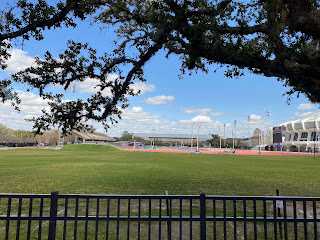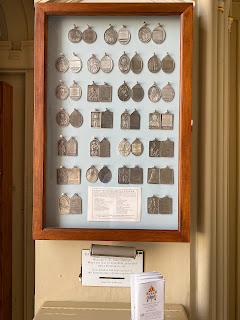Historic Mississippi River Cruise
February 21 - March 1, 2024
I booked the “Historic Mississippi River Cruise” with American Cruise Lines and upgraded their free air and flew roundtrip DFW/New Orleans. Not having visited New Orleans for several years, I paid for two extra hotel nights pre-cruise to spend time in the city. I specifically wanted to visit the National World War II Museum.
Wednesday 21 February - Upon arrival in New Orleans, I connected with Uber and was driven to the Intercontinental Hotel.
I received 4 free drink coupons in Pete's, the hotel bar. After putting my things in the room, I walked around the corner and down Poydras Street to Mother’s Restaurant.
Locals and tourists kept it busy. Customers are handed a menu upon entering and join a line to order and pay at the register. The food is delivered to whatever table the customer occupies.
Thursday 22 February – For breakfast, I walked to Cafe Du Monde
and enjoyed beignets and hot chocolate while listening to the jazz combo playing on the sidewalk. Different men; same music. Nice to know some things don’t really change.
A stop at Aunt Sally’s Praline Kitchen resulted in shipping some home.
After lunch, I walked to the National World War II Museum, an incredible amount of information and artifacts. In the first building is the “Arsenal of Democracy” exhibit telling the story of the United States’ road to war and life on the Home Front. There’s also an exhibit on “The D-Day Invasion.” The second building contains the theater. The third building comprises “Campaigns of Courage.” The exhibit on the first floor, “The Road to Berlin,” tells the story of military campaigns in Europe, Africa, and the Mediterranean through artifacts, videos, and personal stories. The second floor exhibit, “The Road to Tokyo,” retraces the War in the Pacific from Pearl Harbor to Tokyo Bay. Fighting in Southeast Asia, the Himalayas, Burma, China, India, and Alaska with highlights of naval warfare and and air and land campaigns are depicted. Even though I knew many things about the war from studying it, I learned so much more. It was information overload. A Coke float in the museum’s Soda Shop capped my visit.
Friday 23 February - Today was my day to just fool around. Mid-morning I walked over to the French Quarter and window shopped.
Then I sat riverside and watched the traffic on the river and the people walking by. The Natchez (riverboat) played its calliope and blew its whistle before it sailed on a tour. Wanting one last fix of real beignets, I went to Cafe Du Monde and had some for lunch. After eating, I window shopped my way through the Vieux Carre. At Bevolo, I watched a craftsman use rivets to assemble a copper lantern. The company has been making gas and electric lighting fixtures since 1945. My three o’clock massage appointment at Spa Atlantis was money well spent. It was time to go to Pete’s, the hotel bar, for another free drink. While there, I met several of who are also on the cruise. Dinner was one last fix of New Orleans cuisine.
Saturday 24 February -
Today’s Schedule:
7am - Bags ready inside room
6:30am - 9:30am Breakfast
11:15am - Transfer to riverboat
Two motor coaches driven by Captain Dana and Nancy followed us on land up and down the river.
I went to the buffet breakfast about 7. After visiting for a while and meeting several more passengers, I returned to the room until about 10, After checking out, I sat in the lobby and visited until boarding a motor coach just after 11. After a short drive to the pier, I boarded the American Melody. My bag was already in cabin 319 when I arrived. By the time I had unpacked, lunch was being served in the dining room. My balcony was in the shade, so I sat outside until time for the mandatory egress drill at 1:30. The riverboat was tied up almost under a bridge across the Mississippi River. I think it’s the “Huey P. Long Bridge.” Several tow boats with tows (barges) sailed past. Some had twelve or more barges being pushed by one boat; tows are configured to be wider at the front end than at the portion near the tow boat. Also, a buoy tender was being repositioned. After the drill ended, passengers were in the “River Lounge” because that’s everyone’s muster station; the ship was about half full with 95 passengers. “Officer Introductions and Excursions Briefing” was next. At 4, Jim Schweickart lectured with general facts about the Mississippi River. We spent the afternoon sailing upriver with industrial areas lining both banks; not the most scenic of afternoons. Tankers, cargo ships, and barges plied the water; there were no pleasure watercraft on this stretch of the Mississippi. There was a solo travelers meeting at 5; there were 4 of us. Happy hour was followed by dinner: The evening entertainment was Steve Merritt’s “Riverboat Revue,” a comically autobiographical ragtime piano centered show.
The tour to Oak Alley Plantation departed at 1. The drive took between 45 minutes and an hour each way. Don, our guide, shared information about the surrounding area, the plantation, and Louisiana society in general. Oak Alley Plantation is in Vacherie, Louisiana, and to get there we crossed the Mississippi River on the Sunshine Bridge erected using tax dollars by Governor Jimmy Davis to access his family’s property. Originally, the road dead ended at that property just after crossing the bridge. The plantation house, restored in the 1920s by an heir to the Armstrong ranching fortune of South Texas as a retirement home, contains no original furnishings. That being said, no photos are allowed inside. It belongs to a foundation and is operated as a business. Having seen numerous antebellum homes, Oak Alley didn’t meet expectations. The avenue of 28 live oak trees matching the number of columns on the four sides of the house is its most interesting feature. Since the land is and was a sugarcane plantation, there was an interesting video on modern sugarcane farming and sugar production in Louisiana. We also received a complimentary mint julep; I had two.
I missed almost all Clive Siegle’s history presentation on the “Siege of Vicksburg” after dinner. Steve Merritt entertained at the piano after dinner. His was an all-request show.
Tuesday 27 February - We sailed all night. The Captain announced we were doing a bow landing at Vidalia, Louisiana, so I went outside on Deck 3 to watch as the hinged bow lifted and a gangway extended to reach the shore. Captain Dana, Nancy, and the motor coaches were waiting when we docked about 9, and we were almost under the bridge connecting Vidalia to Natchez.
About 9:30, the motor coach departed for the “Natchez Landmark Exploration” tour with Kenny as our guide and Captain Dana at the wheel. While crossing the bridge into Mississippi, I looked below and saw a tow boat with 30 barges. We learned from Kenny that LaSalle, impressed by the bluffs some 22 feet high, founded Fort Rosalie atop the bluffs at Natchez in 1716. He cultivated friendships with the Natchez tribe and relationships were good for several years. In 1729, another French leader began confiscating the Natchez tribe’s lands. They revolted and massacred the French. When the French retaliated, the Natchez tribe almost disappeared. The British controlled the area between 1763 and 1779 and the Spanish from 1779 to 1798. During those times, the area prospered and the Spanish laid out the town of Natchez itself. Passing Dunleith, was the impetus to be reminded that in 1855 Natchez was awash in millionaires from cotton production and sales. Wealthy plantation owners erected mansions as townhouses and filled them with the finest furnishings available.
Our first stop in Natchez was The Basilica of St. Mary, formerly The Cathedral of Our Lady of Sorrows, a gothic church begun in 1843 and completed some 40 years later. Most of the stained glass windows were crafted in Austria.
From there a drive through town took us to the top of the bluff and a view stretching several miles both upstream and downstream.
We returned to the American Melody by reversing our route across the bridge.
Deciding against any afternoon tours, I sat on my balcony with my IPad. At 4, I attended Jim Scherickart‘s lecture, “Signs and Wonders, The Voyage of the New Orleans” about the first steamboat on the Mississippi River. “The Country Cajun Experience” entertained. A fiddle player and an electric guitar player, both of whom sang, performed selections exemplifying the various types of music enjoyed by the Cajun culture. Steve Merritt joined them on piano for a few numbers.

A few of us danced. When it was time to leave, a number of us walked the half mile or so to the riverboat. Fortunately, it never rained, but it was humid.
Thursday 29 February -. At 9, Jim Scherickart‘s lecture was titled “What the Heck?” The talk was a conglomeration of Mississippi River trivia—not particularly interesting or entertaining. After sailing all night, we docked in New Orleans about 11am. The tour to the WWII Museum departed at 1:30. After a short bus ride, we arrived at the museum and received paper wristbands. I toured the museum until after 3:30 when I went to the Victory Theater for the 4D movie, Beyond All Boundaries, narrated by Tom Hanks. This was an emotional experience depicting the sacrifices made to end the threat of tyranny. It was time for Happy Hour when we returned to the riverboat. “Ed Wise and his New Orleans Jazz Band” (bass, clarinet, trumpet, piano, drums) was a fitting end to the cruise.
Friday 1 March – I boarded the bus for the airport transfer at 8:30. My flight to DFW operated as scheduled. After landing, I connected with my ride and was home by 2:30.



















































































































